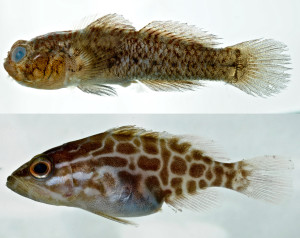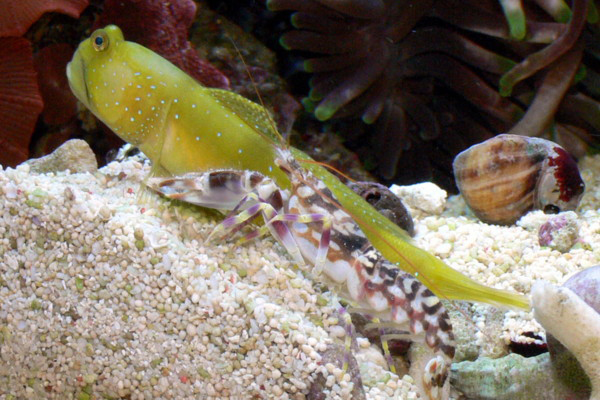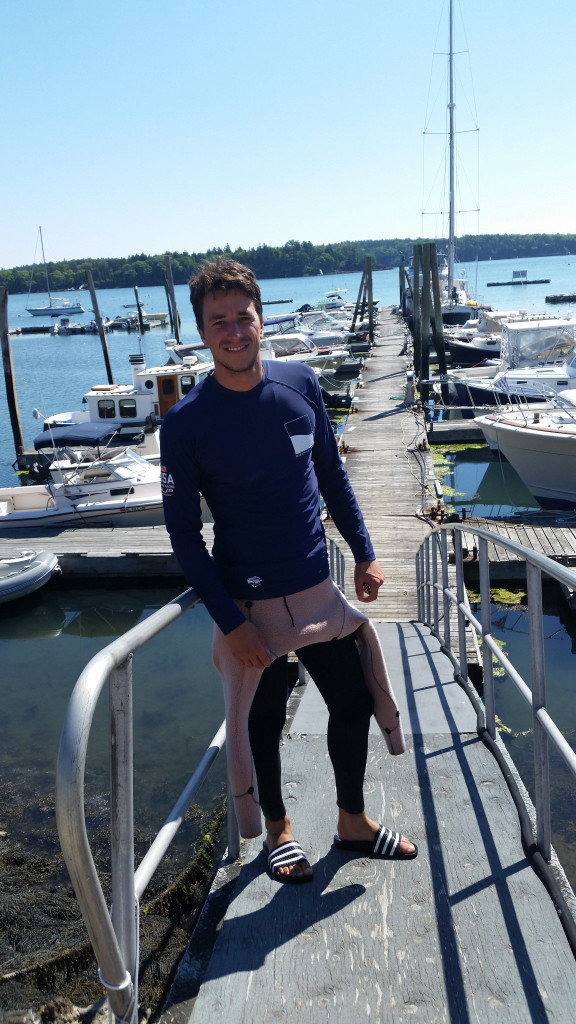Biologists discover endangered Isthmian goby and other elusive fish thriving around dock pilings
by Kristen Minogue

Top: Endangered Isthmian goby (Gobiosoma spilotum) found beneath a dock of Bocas del Toro, Panama. Bottom: Threatened black grouper (Mycoptera bonaci) found beneath a Belize dock. Photos: Simon Brandl & Jordan Casey/Smithsonian
The Panama Canal is home to one of the rarest fish in the world: the Isthmian goby, an endangered, brown-speckled fish less than 3 centimeters long. For years scientists thought it remained only at the locks of the canal’s Caribbean entrance, until a team of Smithsonian biologists found one nearly 200 miles away in a place no one expected.
Isthmian gobies (Gobiosoma spilotum) thrive in shallow waters like tropical tidepools. The expansion of the Panama Canal, along with other coastal development, has eaten up much of their habitat. So scientists were shocked to find the goby circling another manmade structure, a dock off the Panamanian island of Bocas del Toro. The team, from the Smithsonian Environmental Research Center (SERC) and the National Museum of Natural History, reported their discovery in a new study in the journal Ecology and Evolution.
“I didn’t even know what it was at first,” said Simon Brandl, the study’s lead author and SERC biologist. Though he knew it was a goby of some kind, he was unable to pinpoint the species. So Brandl sent the mystery photo to scientists at the Smithsonian’s National Museum of Natural History and the American Museum of Natural History. “They were like, holy cow, this is Gobiosoma spilotum.”
The Isthmian goby isn’t the only rare species the team discovered in dock pilings. Beneath a Belize dock, they found a near-threatened black grouper (Mycteroperca bonaci). Manmade docks—contrary to all expectations—turned out to be popular homes for all kinds of native fish, especially the tiny, hidden ones all but invisible to most divers.
Brandl and the other biologists didn’t set out to find an endangered goby. At the beginning of the study, they were interested in learning about cryptobenthics, the secretive group of fish that includes the Isthmian goby. Cryptobenthic fish live all along the coasts in coral reefs and seagrass beds. But they’re rarely seen because of their small size and propensity to hide from anything larger. Brandl describes life for a cryptobenthic fish as “basically being a Skittle….You get eaten by everything.”
Yes, cryptobenthics are a critical protein source, forming the foundation of marine food webs for larger fish like sharks, goliath groupers and trumpetfish. But it still bites for them.

Tiny cryptobenthic fish are in constant danger of being eaten. To survive, this yellow prawn goby has formed a partnership with a tiger snapping shrimp. The shrimp digs a burrow for them to hide in, and the fish watches the entrance for potential predators. (Credit: Haplochromis, license CC BY-SA 3.0)
Their talent for hiding also means we know next to nothing about cryptobenthic fish. Most fish surveys are done by divers who report only what they can see.
“I can tell with absolute certainty that you’re missing more than 50 percent of the fish that are there if you just look for them,” Brandl said.

Marine biologist Simon Brandl has searched for cryptobenthic fish along the Atlantic,
from Maine (here) to Panama. (Credit: Jonathan Rodemann)
To uncover where cryptobenthics do best, and whether docks help or hurt them, the Smithsonian biologists did a different kind of survey. Brandl, with Jordan Casey, Nancy Knowlton and Emmett Duffy, used fine mesh nets and clove oil, an anesthetic for fishes, to sample tinier fishes that would go unnoticed in a visual survey. They surveyed dock pilings in six sites along the Atlantic, from Maine to Panama. They also sampled coral reefs at the two southernmost sites (Panama and Belize), so they could compare how cryptobenthics did in natural reef habitats versus manmade docks.
They expected to find the docks teeming with invasive fish. After all, that’s the trend for organisms that don’t swim, like shellfish and sponges. But instead, they found flourishing communities of native fish.
In total, the scientists found 58 native fish species at all the docks and only one invader, the lionfish Pterois volitans. Tropical sites like Belize and Florida had the most native species (21 and 19), while Massachusetts and Maine each had four. That wasn’t shocking, as the tropics generally boast more diversity than cooler zones farther from the equator. The two Panama docks had 14 native fish species, including the endangered Isthmian goby in Bocas del Toro—186 miles away from the Panama Canal.
“These docks may in fact be offering some kind of refuge for species that would otherwise struggle,” Brandl said.
Perhaps, Brandl speculates, docks harbor cryptobenthic fish because they’re similar to underwater mangrove roots, where Isthmian gobies may have once flourished. Mangrove swamps and dock pilings tend to have murkier water, making them ideal hiding places for small fish. And once gobies settle on a dock piling, they generally stay for life, Brandl added. “These fish are terrible swimmers….as soon as they would move away from a piling, they’re essentially fish food.”
In possibly the most uplifting sign, the dock-dwelling fish provide living proof that humanity and nature can support each other.
“Putting dock pilings in has no extra effort whatsoever. We’re going to do that anyway,” Brandl said, and discovering hidden communities of cryptobenthics there is an encouraging sign. “It means that we have a really efficient, low-cost way of helping to preserve native fish biodiversity.”
Learn More About Cryptobenthics: The Tiny Fish Awards

